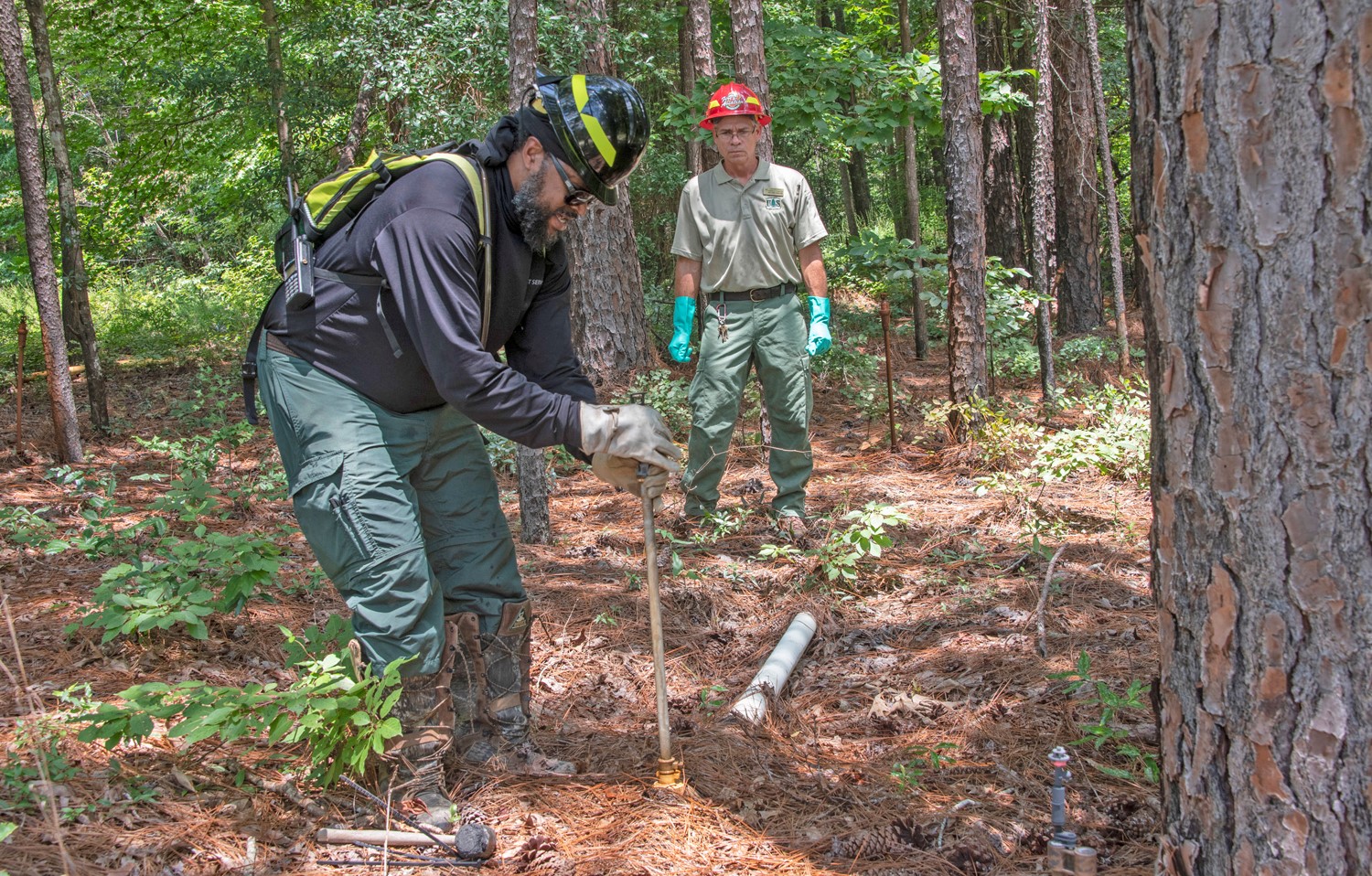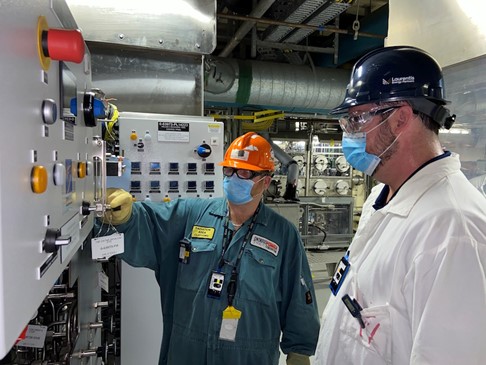U.S. Forest Service employees Secunda Hughes (left) and Andrew Thompson inspect irrigation piping and sprinkler heads, part of a 62-acre pine plantation used to safely disperse tritium at the Savannah River Site.
The Department of Energy’s Office of Environmental Management (EM) is managing the release of tritiated water using a 62-acre plantation of pine trees and other natural resources to limit radioactively contaminated groundwater from reaching waterways on the Savannah River Site in South Carolina.
(Click photo to enlarge) One of 16 AC100M gas centrifuges built by Centrus Energy for HALEU production in Piketon, Ohio. (Photo: Centrus Energy)
For years, pressure has been building for a commercial path to a stable supply of high-assay low-enriched uranium (HALEU)—deemed essential for the deployment of advanced power reactors—but advanced reactor developers and enrichment companies are still watching and waiting. In contrast, the uranium spot price soared after Sprott Physical Uranium Trust, a Canadian investment fund formed in July, began buying up U3O8 supplies, causing the price to increase over 60 percent, topping $50 per pound for the first time since 2012. Fueled by growing acknowledgment that nuclear power is a necessary part of a clean energy future, uranium is the focus of attention from Wall Street to Capitol Hill.
U.S. energy secretary Jennifer Granholm and IAEA director general Rafael Mariano Grossi pose for a photo before their September 21 meeting announcing the next International Ministerial Conference on Nuclear Power in the 21st Century. (Photo: D. Calma/IAEA)
U.S. energy secretary Jennifer Granholm and International Atomic Energy Agency director general Rafael Mariano Grossi met in Vienna yesterday during the agency’s 65th General Conference to launch preparations for the next IAEA International Ministerial Conference on Nuclear Power in the 21st Century, slated for October 26–28, 2022, in Washington, D.C.
During a fluorescence spectroscopy experiment at LLNL, the protein lanmodulin makes radioactive curium glow when exposed to UV light in the sample to the right. The schematic (left) represents the structure of the curium-protein complex, with three curium atoms bound per molecule of protein. (Photo: LLNL)
Scientists at Lawrence Livermore National Laboratory, working in collaboration with researchers at Penn State University and Harvard Medical School, have discovered a new mechanism by which radionuclides could spread in the environment.
The research, which has implications for nuclear waste management and environmental chemistry, was published in the Journal of the American Chemical Society on September 20.
Having completed three separate decommissioning projects, EnergySolutions takes the final steps in restoring the sites to a natural state.
For any nuclear power plant that has been permanently shut down, site restoration is the ultimate decommissioning goal when contracting with a utility to demolish a facility. The task, however, is not as simple as mobilizing heavy equipment and waving a wrecking ball or planting explosives to implode the facility, then loading up the debris and sending it to a landfill.
There is a real science and engineering approach necessary to safely restore the land to its original state. That has been the goal for EnergySolutions over the past decade as the company works to safely decommission shuttered nuclear power plants—packaging, transporting, and disposing of the waste, and restoring the sites for whatever reuse the owners and host communities see fit.
The headframe and buildings at the Gorleben salt dome in Germany. (Photo: Wikimedia Commons)
The German government has announced that it is closing the Gorleben salt mine in the Wendland region of Lower Saxony, officially removing the site from consideration as a repository for radioactive waste. Gorleben became a target of antinuclear protests after being proposed as a potential repository in the 1970s.
September 20, 2021, 12:04PMNuclear Newsthe Standards Committee An artist’s rendering of the NuScale plant. (Image: NuScale)
For more than two decades, the American Nuclear Society’s Standards Committee has recognized the benefit of incorporating risk-informed and performance-based (RIPB) methodology into ANS standards to improve their effectiveness, efficiency, and transparency. In general, standards using RIPB methods with properly identified and structured objectives need less modification and can be expected to remain valid for much longer periods.
BWXT Canada’s Cambridge, Ontario, facility. (Photo: BWXT Canada)
NuScale Power announced earlier this week that manufacturing process development work on its small modular reactor—the NuScale Power Module—is advancing at BWXT Canada Ltd.’s Cambridge, Ontario, facility in preparation for module fabrication. NuScale said that this work is critical to the development of its SMR technology and is an example of the supply chain development opportunities for Canadian companies with the requisite power plant equipment expertise.
Rendition of the IMSR400 power plant in the configuration proposed for the Darlington site. (Image: Terrestrial Energy)
Terrestrial Energy has upgraded the design of its Integral Molten Salt Reactor (IMSR) nuclear power plant, the company announced on September 14. The proposed facility will now feature 390 MWe of generation capacity for grid supply from twin reactors and generators.
Illinois governor J.B. Pritzker appreciates applause at the signing event for the state's new energy bill.
In an hour-long ceremony held yesterday at Chicago’s Shedd Aquarium amid some fanfare (it included an appearance by lizards, a snake, and a penguin), Illinois Gov. J.B. Pritzker signed into law the Climate and Equitable Jobs Act (S.B. 2408). The bill is a sweeping overhaul of the state’s energy policies aimed at phasing out fossil-fuel power generation and placing Illinois on a path to become a 100 percent carbon-free energy producer by 2050.
Don Perrie (left), of OPG, and Michael Lefebvre, of Laurentis Energy Partners, examine the He-3 extraction tool installed at Darlington NPP
Laurentis Energy Partners, a subsidiary of Ontario Power Generation (OPG), has launched a new program to produce helium-3. The He-3 will be obtained from tritium stored at OPG’s Darlington nuclear power plant, a four-unit CANDU station located about 100 kilometers east of Toronto.
Darlington houses one of the world’s largest reserves of tritium, which is a by-product of the heavy water used in CANDU reactors.
 and Andrew Thompson.jpg)









 The International Atomic Energy Agency has revised upward its projections regarding the potential growth of nuclear power’s capacity for electricity generation over the next three decades. The upward revision is the first by the IAEA since the Fukushima Daiichi accident in 2011.
The International Atomic Energy Agency has revised upward its projections regarding the potential growth of nuclear power’s capacity for electricity generation over the next three decades. The upward revision is the first by the IAEA since the Fukushima Daiichi accident in 2011.





. of OPG, and Michael Lefebvre, of Laurentis Energy Partners, examine tew He-3 extraction tool installed at Darlington NPP.jpg)